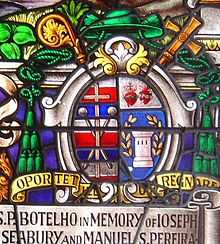Stephen Alencastre




Bishop Stephen Peter Alencastre, SS.CC. (November 3, 1876 – November 9, 1940), was the fifth and last Vicar Apostolic of the Vicariate Apostolic of the Hawaiian Islands, now the Roman Catholic Diocese of Honolulu.
Born on the island of Porto Santo in the Madeira Islands of Portugal[1] as Estêvão Pedro de Alencastre, and brought to Hawaii as an infant, Alencastre later returned to Europe to finish his seminary studies in Belgium. He was ordained to the priesthood on April 5, 1902, at the age of 25, as a member of the Congregation of the Sacred Hearts of Jesus and Mary and returned to serve the people of Hawaii.
When the Vicar Apostolic, Libert H. Boeynaems, SS.CC., fell ill, Alencastre was appointed by Pope Pius XI as coadjutor Vicar Apostolic, with the right of succession, on April 29, 1924. On August 24 of that year, he was consecrated Titular Bishop of Arabissus at the age of 47. Upon the death of Boeynaems on May 13, 1926, Alencastre automatically succeeded him as Vicar Apostolic of the Hawaiian Islands. He was the first bishop in Hawai‘i to have been raised in the Hawaiian Islands.
Alencastre's personal mission included continuing to expand the number of schools and parish churches in the Islands (and to renovate the existing ones) and to build a seminary to form vowed religious locally to the priesthood. This came to fruition with the building of St. Stephen's Seminary, named in honor of the Bishop's own patron saint. The seminary is still in use. The bishop was also partly responsible for the increase in the variety of religious orders in Hawaii, inviting such groups as the Sisters of St. Joseph of Carondelet to help with the growth of the Catholic faith in the Islands.
Alencastre died while returning to Hawaii on a boat from Los Angeles in 1940 and was interred at the Honolulu Catholic Cemetery in downtown Honolulu. Following his death, he was posthumously awarded the honor of "Officer of the Order of the Crown" by King Leopold III of Belgium, and a street in Honolulu also carries his surname in his honor.
After continuing and completing much of the work begun by Alencastre and his Sacred Hearts predecessors, the mission area of the Hawaiian Islands was elevated to the status of the Diocese of Honolulu by Pope Pius XII a few months following his death. The history of the Catholic Sacred Hearts mission in the Hawaiian Islands was documented by one of the congregation's priests and later compiled and published in a book called Pioneers of the Faith.
A window in the Cathedral of Our Lady of Peace in Honolulu depicts his episcopal crest, as well as a portrayal of a blessing being bestowed upon him by Pope Pius XI. His episcopal motto was "Opportet illum regnare," derived from a phrase in 1 Corinthians 15: 24-26, meaning "He (Christ) must reign." Bishop Alencastre was the first to include in his episcopal crest the pūlo‘ulo‘u (kapu sticks), traditional weapons of the Hawaiian people, and the colors of the Hawaiian flag. In keeping with the traditions of ecclesiastical heraldry, he utilized the green galero, a hat reserved for bishops and cardinals, at the top of his crest.
References
- ↑ "Distinguished Americans & Canadians of Portuguese Descent". Retrieved 2008-01-09.
| Catholic Church titles | ||
|---|---|---|
| Preceded by Libert H. Boeynaems |
Vicar Apostolic of the Hawaiian Islands 1926–1940 |
Succeeded by Roman Catholic Bishop of Honolulu |